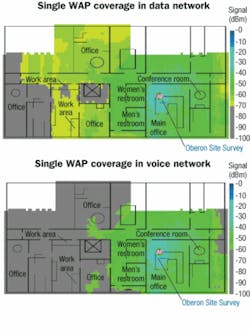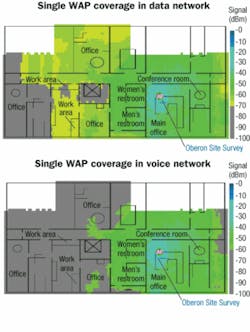Users may sneer if the wireless network’s SNIR is insufficient to handle multiple voice connections simultaneously.
For many enterprise network operators, the next step in their converged network will be to engage Voice over IP over the wireless local area network (VoWi-Fi).
The wireless LAN (WLAN) has proven the utility of workplace mobility for data connectivity, and this benefit can now be extended to voice. VoWi-Fi has another compelling driver-the recent introduction of dual-mode VoWi-Fi/cellular handsets lets users reduce corporate “air time minutes” while within range of the enterprise Wi-Fi network.
A VoWi-Fi network design, however, has special requirements above and beyond those of the wireless data network-not the least of which is that the telephone user has come to expect a dial tone every time the handset is picked up. The human audio processing circuitry is highly intolerant of delay or latency in delivery of syllables, and the user, while talking on the mobile handset, is more likely to roam than, say, a data user accessing a file off the server. These expectations lead to an enhanced requirement for coverage, capacity, and packet delivery, along with session persistence while roaming.
Coverage concerns
Many VoWi-Fi handset manufacturers recommend a signal-to-noise plus interference ratio (SNIR) of 20 to 25 dB for their handsets. This means that for the handset to operate reliably, it must be covered by the radio signal of the wireless access point (WAP) such that the desired radio signal is 20 to 25 dB greater than all combined noise and interference sources.
This level defines what is called the “fringe” of the radio coverage. As the handset user walks beyond the fringe of radio coverage, the desired radio signal begins to fade, the SNIR drops below the 20 to 25-dB level, and handset performance may not be reliable. Note that the desired 20 to 25-dB SNIR is much higher than the 10 to 15-dB SNIR normally specified for an all-data network. This 10 dB difference means that the voice handset needs to receive 10 times more power than a data device. The consequence is that a facility RF (radio frequency) coverage survey performed only for data devices won’t be accurate for a VoWi-Fi implementation.
The figures on page 64 show the coverage of a single WAP for data and voice applications. Notice how much less area is covered adequately when the fringe is established for a voice SNIR. Ideally, the RF coverage survey will be performed using the WAP and antennas intended to be used in the final implementation. You should mount the WAP and antennas in such a way as to emulate the final installation, including such issues as whether the WAP is wall- or ceiling-mounted, and whether the antennas are on a ground plane. The survey should be performed to establish the SNIR fringe level recommended by the handset manufacturer.
In general, when you perform an RF coverage survey, a you use a handheld analyzer or survey tool to establish the SNR fringe for a single WAP. A second WAP (at a different channel) can be placed on the fringe, ensuring thorough coverage and some coverage overlap. A third WAP is placed at the second WAP’s fringe, and so on. In the absence of other WAPs, the fringe is simply the signal to (random background) noise ratio; however, the final implementation obviously will comprise numerous WAPs. In that case, the limiting factor is interference (signal-to-interference ratio, or SIR) from other nearby WAPs and handsets on the same channel, rather than just the random background noise.
This is where channel planning takes on heightened importance. The WAPs can be configured to operate on designated channels. For 802.11b/g WAPs, there are three non-overlapping (or four slightly overlapping) channels. The channel plan consists of using the three or four available channels to maximize the distance between WAPs on the same channel.
In any enterprise installation with four or more WAPs and continuous coverage, even with ideal channel planning, there will be interference at any WAP that shares a channel with another. The SIR can reduce the basic SNR by 10 to 20 dB depending on the number of WAPs and handsets that share the channel. In addition to WAP spacing and channel plan, the SIR degradation also depends on network loading, as the interference only occurs when there are transmissions from the co-channel WAPs or handsets.
VoWi-Fi handsets cans have a lower transmit-power capability than WAPs. You can achieve increased capacity and extended handset battery duration by using lower handset power, so set the WAP and handset power to the same level. There is no advantage in having the WAP transmit at a higher power than the handset device; in fact, it just adds to interference. Make sure that the survey power is the same as the operational handset power. WAPs that support automatic power adjustment should be configured for static power only.
WAPs have a pair of antennas for transmit-and-receive diversity, which improves the communication channel, especially indoors. The WAPs should be installed with both antennas attached. Ideally, the antennas should be mounted as high as possible (on the ceiling, if practical), but not obscured by ceiling tiles or walls. Mounting on a conductive ground plane will have the effect of flattening the antenna pattern, reducing interference on adjacent floors.
Capacity is critical
In a VoWi-Fi implementation, capacity may be more important than coverage. A typical assumption in a data network is that a maximum of 15 client devices could be associated with WAPs at any time. This can be easily planned for, as the number of seats in an office area or conference room can be readily predicted. But predicting the number of connected handsets may be more difficult as the likelihood of roaming talkers is higher than roaming data users. Rather than seats covered by a WAP, considerations for the voice network include number of handsets to be issued, the density of handset users, and an expectation for how many minutes per hour the average handset will be in a call.
To minimize latency and collisions, it may be necessary to design the network for a maximum of 10 or fewer connected devices per WAP. If the density of handset users is equivalent to the density of data users, the WAPs will need to be closer together to reduce the number of handsets connected to any given WAP (and, consequently, the WAPs’ power will need to be reduced to preserve the desired SIR). In any case, a VoWi-Fi implementation is likely to be more expensive than a traditional data implementation due to an increase in the number of WAPs to be installed.
Most WAPs support automatic data-rate selection. When the WAP receives a strong signal level at the handset, it selects the highest data rate. As the handset travels away from the WAP, thereby reducing received signal strength, the WAP selects a lower data rate, thereby extending the WAP’s coverage area. Most handset manufacturers recommend that automatic data-rate selection be enabled in the WAP.
Several factors impact WAP bandwidth use. The effective data rate for carrying voice bits is only 30 to 50% of the over-the-air signaling rate specified by WAP manufacturers. The type of codec used by the handset vendor, and the packet rate, will determine the voice packet size. The percentage of bandwidth used increases for lower data rates, so as the handset moves away from the WAP, the data rate is reduced and the voice packets consequently take a bigger percentage of bandwidth. For example, a call using 64-kbits/sec codec (G.711) uses 4.5% of available WAP bandwidth at 11 Mbits/sec, and 12% at 2 Mbits/sec.
Many WAPs support dual-mode operation (802.11b/g and 802.11a). Although the 802.11a mode offers more independent channels and could offer more capacity for a voice network, most of the commercial VoWi-Fi handsets operate in the 802.11b mode only. One solution is to use the 802.11a network for data, and 802.11b for voice. Because 802.11a has a shorter propagation range than 802.11b/g, a higher WAP density again is justified (but more expensive).
Typical data networks are tolerant of packets being delayed or completely dropped. In fact, the Internet Protocol in general, and the IEEE 802.11 standard in particular, are designed to accept and tolerate packet errors, allowing retransmission of data packets. With data applications, delays caused by retransmissions are not noticeable. The quality of the VoWi-Fi call, on the other hand, is largely dependent on the latency, or delay, in packet delivery to and from the handset. So, delays of a few tens of milliseconds are noticeable. The latency may have many sources, including packet errors requiring packet retransmittal. This requirement for successful packet delivery is the driving factor for the increased SNIR on the VoWi-Fi network.
Likewise, session persistence is a requirement since roaming voice users move from office to office. For wireless data applications, such as accessing files from a server, maintaining session persistence is not critical. For example, if a large file is being downloaded while a laptop is moved from office to office, the Transmission Control Protocol session will retransmit lost packets. The voice user, however, demands a rapid and lossless handoff to ensure continuity of coverage.
The solution for low latency is a combination of good infrastructure design for coverage and capacity, and selection of network equipment to support quality of service (QoS), which reduces latency by prioritizing voice packets. Session persistence requires that the WAPs communicate with each other to exchange handoff information, and because this inter-WAP communication is not covered by the 802.11 standard, the infrastructure deployment will be made up of a single-vendor solution that addresses inter-WAP communication. Also, with certain security implementations, vendor-specific handoff exchanges occur with the handset.
New design considerations
The economics and utility of converging the mobile voice network with the mobile data network are compelling, but will require new considerations in infrastructure design. The number of active handsets, call duration, roaming, battery duration, and WAP placement will all require consideration. When selecting handset and WAP vendors, review their data sheets carefully for impact on infrastructure design.SCOTT D. THOMPSON is president of Oberon Inc. (www.oberonwireless.com).

